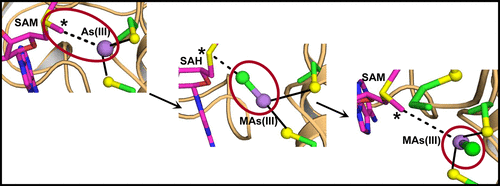Our official English website, www.x-mol.net, welcomes your feedback! (Note: you will need to create a separate account there.)
Reorientation of the Methyl Group in MAs(III) is the Rate-Limiting Step in the ArsM As(III) S-Adenosylmethionine Methyltransferase Reaction
ACS Omega ( IF 4.1 ) Pub Date : 2018-03-14 00:00:00 , DOI: 10.1021/acsomega.8b00197 Charles Packianathan 1 , Jiaojiao Li 1 , Palani Kandavelu 2 , Banumathi Sankaran 3 , Barry P. Rosen 1
ACS Omega ( IF 4.1 ) Pub Date : 2018-03-14 00:00:00 , DOI: 10.1021/acsomega.8b00197 Charles Packianathan 1 , Jiaojiao Li 1 , Palani Kandavelu 2 , Banumathi Sankaran 3 , Barry P. Rosen 1
Affiliation

|
The most common biotransformation of trivalent inorganic arsenic (As(III)) is methylation to mono-, di-, and trimethylated species. Methylation is catalyzed by As(III) S-adenosylmethionine (SAM) methyltransferase (termed ArsM in microbes and AS3MT in animals). Methylarsenite (MAs(III)) is both the product of the first methylation step and the substrate of the second methylation step. When the rate of the overall methylation reaction was determined with As(III) as the substrate, the first methylation step was rapid, whereas the second methylation step was slow. In contrast, when MAs(III) was used as the substrate, the rate of methylation was as fast as the first methylation step when As(III) was used as the substrate. These results indicate that there is a slow conformational change between the first and second methylation steps. The structure of CmArsM from the thermophilic alga Cyanidioschyzon merolae sp. 5508 was determined with bound MAs(III) at 2.27 Å resolution. The methyl group is facing the solvent, as would be expected when MAs(III) is bound as the substrate rather than facing the SAM-binding site, as would be expected for MAs(III) as a product. We propose that the rate-limiting step in arsenic methylation is slow reorientation of the methyl group from the SAM-binding site to the solvent, which is linked to the conformation of the side chain of a conserved residue Tyr70.
中文翻译:

MAs(III)中甲基的重新定向是ArsM As(III)S-腺苷甲硫氨酸甲基转移酶反应中的限速步骤
三价无机砷(As(III))最常见的生物转化是甲基化为单,二和三甲基化物质。甲基化被As(III)S催化-腺苷甲硫氨酸(SAM)甲基转移酶(在微生物中称为ArsM,在动物中称为AS3MT)。甲基亚砷酸盐(MAs(III))既是第一甲基化步骤的产物,也是第二甲基化步骤的底物。当以As(III)为底物测定总甲基化反应的速率时,第一甲基化步骤是快速的,而第二甲基化步骤是缓慢的。相反,当将MAs(III)用作底物时,甲基化速率与将As(III)用作底物时的第一甲基化步骤一样快。这些结果表明在第一和第二甲基化步骤之间存在缓慢的构象变化。嗜热藻类Cyanidioschyzon merolae CmArsM的结构sp。用结合的MAs(III)以2.27Å的分辨率测定5508。甲基面对溶剂,就像将MAs(III)结合为底物时所预期的那样,而不是面对MAs(III)产品所预期的SAM结合位点。我们提出砷甲基化的限速步骤是将甲基从SAM结合位点缓慢重新定向到溶剂,这与保守残基Tyr70的侧链构象有关。
更新日期:2018-03-14
中文翻译:

MAs(III)中甲基的重新定向是ArsM As(III)S-腺苷甲硫氨酸甲基转移酶反应中的限速步骤
三价无机砷(As(III))最常见的生物转化是甲基化为单,二和三甲基化物质。甲基化被As(III)S催化-腺苷甲硫氨酸(SAM)甲基转移酶(在微生物中称为ArsM,在动物中称为AS3MT)。甲基亚砷酸盐(MAs(III))既是第一甲基化步骤的产物,也是第二甲基化步骤的底物。当以As(III)为底物测定总甲基化反应的速率时,第一甲基化步骤是快速的,而第二甲基化步骤是缓慢的。相反,当将MAs(III)用作底物时,甲基化速率与将As(III)用作底物时的第一甲基化步骤一样快。这些结果表明在第一和第二甲基化步骤之间存在缓慢的构象变化。嗜热藻类Cyanidioschyzon merolae CmArsM的结构sp。用结合的MAs(III)以2.27Å的分辨率测定5508。甲基面对溶剂,就像将MAs(III)结合为底物时所预期的那样,而不是面对MAs(III)产品所预期的SAM结合位点。我们提出砷甲基化的限速步骤是将甲基从SAM结合位点缓慢重新定向到溶剂,这与保守残基Tyr70的侧链构象有关。



























 京公网安备 11010802027423号
京公网安备 11010802027423号